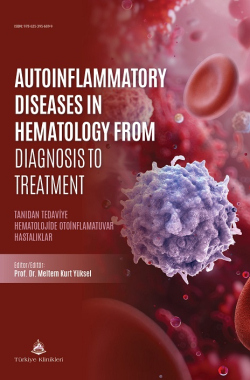CYTOKINE STORM SYNDROMES
INTRODUCTION
Autoinflammatory diseases (AIDs) are a wide spectrum of diseases with complex pathology, characterized by recurrent attacks of sterile inflammation resulting from dysregulation of the innate immune system.1 They are usually caused by single gene mutations related to the immune system, but they can be polygenic or multifactorial in origin. Most AIDs are associated with activation of the Interleukin-1 pathway and are generally driven by mutations in genes encoding proteins involved in the assembly of inflammasomes.2 Understanding the pathobiology and clinical differentiation of this rare group of diseases with heterogeneous etiology can be challenging.
Cytokine storm syndrome (CSS), including hemophagocytic lymphohistiocytosis (HLH), macrophage activation syndrome (MAS), and cytokine release syndrome (CRS), is a life-threatening systemic inflammatory condition characterized by elevated levels of circulating cytokines and immune cell hyperactivation that can be triggered by infectious pathogens, malignancies, and AIDs.3 The term cytokine storm syndrome (CSS) was first used to define elevated cytokine levels in graft versus host disease after allogeneic HSCT, and acute pancreatitis.4,5 Currently, this notion has been applied to diverse noninfectious and infectious conditions, such as COVID-19 pandemic.6
HLH is life-threatening state characterized by overstimulation of the immune system resulting in hypercytokinemia and uncontrolled systemic inflammation.7 The cytokine storm syndrome observed in HLH is characterized by excessive stimulation of proinflammatory pathways which overwhelms anti-inflammatory regulatory mechanisms.8 Castleman disease describes a group of several disorders involving systemic inflammation, characteristic lymph node pathology, and multiorgan dysfunction resulting from hypercytokinemia.8
In this review, we will focus on the two biologically different types of CSS, and the current knowledge on the relationship of immunopathogenesis and the contribution of host genetics are discussed.
Prof. Dr. Gülşah Kaygusuz
Ankara University, Faculty of Medicine,
Department of Medical Pathology,
Ankara, Türkiye
Referanslar
- An J, Marwaha A, Laxer RM. Autoinflammatory Diseases: A Review. J Rheumatol. 2024;51:848-61. jrheum.2023-1209 [Crossref] [PubMed]
- Broderick L, Hoffman HM. IL-1 and autoinflammatory disease: biology, pathogenesis and therapeutic targeting. Nat Rev Rheumatol. 2022; 18(8):448-463. [Crossref] [PubMed] [PMC]
- Fajgenbaum DC, June CH. Cytokine Storm. N Engl J Med. 2020;383(23):2255-2273. [Crossref] [PubMed] [PMC]
- Ferrara JL, Abhyankar S, Gilliland DG. Cytokine storm of graft-ver-sus-host disease: a critical effector role for interleukin-1. Transplant Proc. 1993;25: 1216-1217. [PubMed]
- Makhija R, Kingsnorth AN. Cytokine storm in acute pancreatitis. J Hepatobiliary Pancreat Surg. 2002;9: 401-410. nih.gov/12483260/ [Crossref] [PubMed]
- Chen LYC, Quach TTT. COVID-19 cytokine storm syndrome: a threshold concept. Lancet Microbe. 2021;2(2):e49-e50. nlm.nih.gov/33655230/ [Crossref] [PubMed]
- Hayden A, Park S, Giustini D, Lee AY, Chen LY. Hemophagocytic syndromes (HPSs) including hemophagocytic lymphohistiocytosis(HLH) in adults: a systematic scoping review. Blood Rev. 2026;30: 411-420. [Crossref] [PubMed]
- Henrie R, Cherniawsky H, Marcon K, Zhao EJ, Marinkovic A, Pourshahnazari P, Parkin S, and Chen LYC. Inflammatory diseases in hematology: a review. Am J Physiol Cell Physiol. 2022;323: C1121-C1136. [Crossref] [PubMed]

